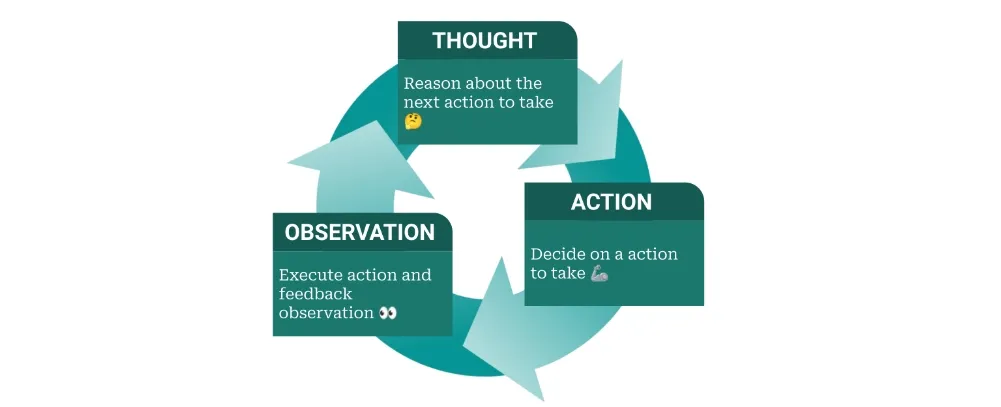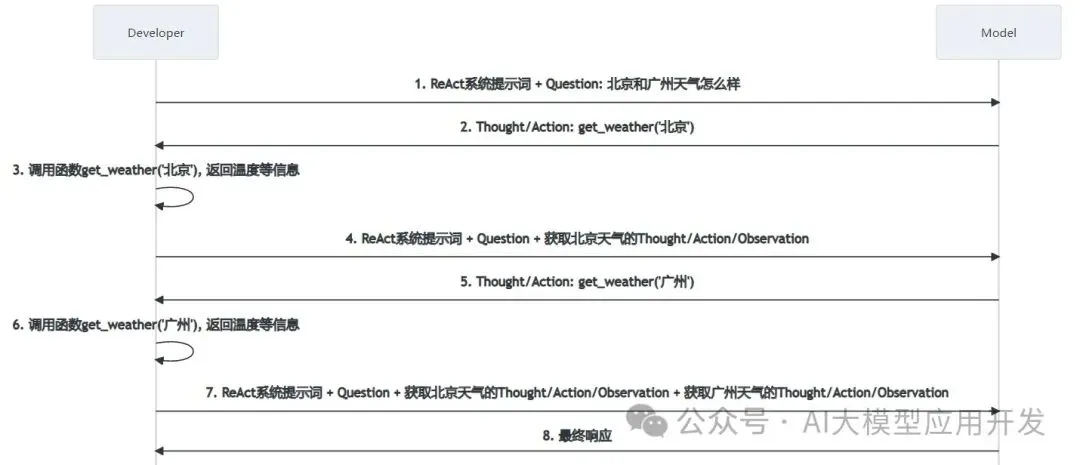
前言
AI智能体是指具备一定自主性、能感知环境并通过智能决策执行特定任务的软件或硬件实体。它结合了人工智能技术(如机器学习、自然语言处理、计算机视觉等),能够独立或协作完成目标。
基于大语言模型(LLM)的Function Calling可以令智能体实现有效的工具使用和与外部API的交互。支持Function Calling的模型(如gpt-4,qwen-plus等)能够检测何时需要调用函数,并输出调用函数的函数名和所需参数的JSON格式结构化数据。
但并非所有的LLM模型都支持Function Calling(如deepseek-v3)。对于不支持Function Calling的模型,可通过ReAct的相对较为复杂的提示词工程,要求模型返回特定格式的响应,以便区分不同的阶段(思考、行动、观察)。
工具调用主要有两个用途:
- 获取数据: 例如根据关键字从知识库检索内容、通过特定API接口获取业务数据
- 执行行动: 例如通过API接口修改业务状态数据、执行预定业务操作
本文包含如下内容:
- ReAct基础
- 详细介绍基于ReAct的工具调用流程和涉及的交互消息
- 手搓Agent代码实现基于ReAct的工具调用
ReAct基础
ReAct源于经典论文: REACT: SYNERGIZING REASONING AND ACTING IN LANGUAGE MODELS (链接:https://arxiv.org/pdf/2210.03629)
基于ReAct的智能体为了解决问题,需要经过几个阶段
- Thought: 思考推理
- Action:作出行动,决定要调用的工具和参数
- Observation:行动的结果(工具输出)
以上3个阶段可能迭代多次,直到问题得到解决或者达到迭代次数上限。

基于ReAct的工具调用依赖于复杂的提示词工程。系统提示词参考langchain的模板:
复制Answer the following questions as best you can. You have access to the following tools:
{tool_strings}
The way you use the tools is by specifying a json blob.
Specifically, this json should have a `action` key (with the name of the tool to use) and a `action_input` key (with the input to the tool going here).
The only values that should be in the "action" field are: {tool_names}
The $JSON_BLOB should only contain a SINGLE action, do NOT return a list of multiple actions. Here is an example of a valid $JSON_BLOB:
```
{{{{
"action": $TOOL_NAME,
"action_input": $INPUT
}}}}
```
ALWAYS use the following format:
Question: the input question you must answer
Thought: you should always think about what to do
Action:
```
$JSON_BLOB
```
Observation: the result of the action
... (this Thought/Action/Observation can repeat N times)
Thought: I now know the final answer
Final Answer: the final answer to the original input question
Begin! Reminder to always use the exact characters `Final Answer` when responding.基于ReAct的工具调用流程和交互消息
我们以查询北京和广州天气为例,LLM采用阿里云的deepseek-v3。查询天气的流程如下图:

1. 发起查询请求
向LLM发起查询时,messages列表有2条messages:
- 第1条role为system,定义了系统提示词(含工具定义)
- 第2条role为user,包含如下内容:
Question: 北京和广州天气怎么样
我们用curl发起POST请求,body的JSON结构可参考https://platform.openai.com/docs/api-reference/chat/create 。
复制请求里的stop字段需要设置为Observation:,否则LLM会直接输出整个Thought/Action/Observation流程并给出虚构的最终答案。我们仅需要LLM输出Thought/Action即可
#!/bin/bash
export OPENAI_BASE_URL="https://dashscope.aliyuncs.com/compatible-mode/v1"
export OPENAI_API_KEY="sk-xxx" # 替换为你的key
curl ${OPENAI_BASE_URL}/chat/completions \
-H "Content-Type: application/json" \
-H "Authorization: Bearer $OPENAI_API_KEY" \
-d '{
"model": "deepseek-v3",
"messages": [
{
"role": "system",
"content": "\nAnswer the following questions as best you can. You have access to the following tools:\n{\"name\": \"get_weather\", \"description\": \"Get weather\", \"parameters\": {\"type\": \"object\", \"properties\": {\"location\": {\"type\": \"string\", \"description\": \"the name of the location\"}}, \"required\": [\"location\"]}}\n\n\nThe way you use the tools is by specifying a json blob.\nSpecifically, this json should have a `action` key (with the name of the tool to use) and a `action_input` key (with the input to the tool going here).\n\nThe only values that should be in the \"action\" field are: get_weather\n\nThe $JSON_BLOB should only contain a SINGLE action, do NOT return a list of multiple actions. Here is an example of a valid $JSON_BLOB:\n\n```\n{{\n\"action\": $TOOL_NAME,\n\"action_input\": $INPUT\n}}\n```\n\nALWAYS use the following format:\n\nQuestion: the input question you must answer\nThought: you should always think about what to do\nAction:\n```\n$JSON_BLOB\n```\nObservation: the result of the action\n... (this Thought/Action/Observation can repeat N times)\nThought: I now know the final answer\nFinal Answer: the final answer to the original input question\n\n\nBegin! Reminder to always use the exact characters `Final Answer` when responding. \n"
},
{
"role": "user",
"content": "Question: 北京和广州天气怎么样\n\n"
}
],
"stop": "Observation:"
}'2. LLM返回Action获取北京天气
LLM经过推理,发现需要先调用函数获取北京天气。
复制Thought: 我需要获取北京和广州的天气信息。首先,我将获取北京的天气。
Action:
```
{
"action": "get_weather",
"action_input": {
"location": "北京"
}
}
```完整的JSON响应如下:
复制{
"choices": [
{
"message": {
"content": "Thought: 我需要获取北京和广州的天气信息。首先,我将获取北京的天气。\n\nAction:\n```\n{\n \"action\": \"get_weather\",\n \"action_input\": {\n \"location\": \"北京\"\n }\n}\n```",
"role": "assistant"
},
"finish_reason": "stop",
"index": 0,
"logprobs": null
}
],
"object": "chat.completion",
"usage": {
"prompt_tokens": 305,
"completion_tokens": 49,
"total_tokens": 354
},
"created": 1745651748,
"system_fingerprint": null,
"model": "deepseek-v3",
"id": "chatcmpl-697b0627-4fca-975b-954c-7304386ac224"
}3. 处理函数调用获取北京天气
解析处理LLM的Action获得函数名和参数列表,调用相应的API接口获得结果。
例如:通过http://weather.cma.cn/api/now/54511可获得北京的天气情况。
完整的JSON响应如下:
复制{
"msg": "success",
"code": 0,
"data": {
"location": {
"id": "54511",
"name": "北京",
"path": "中国, 北京, 北京"
},
"now": {
"precipitation": 0.0,
"temperature": 23.4,
"pressure": 1005.0,
"humidity": 43.0,
"windDirection": "西南风",
"windDirectionDegree": 216.0,
"windSpeed": 2.7,
"windScale": "微风",
"feelst": 23.1
},
"alarm": [],
"jieQi": "",
"lastUpdate": "2025/04/26 15:00"
}
}4. 把上下文信息以及函数调用结果发给LLM
发给LLM的messages列表有2条messages:
- 第1条role为system,定义了系统提示词(含工具定义)
- 第2条role为user,包含如下内容:
Question: 北京和广州天气怎么样
Thought: 我需要获取北京和广州的天气信息。首先,我将获取北京的天气
Action: {"action":"get_weather","action_input":{"location":"北京"}}
Observation: 工具调用get_weather('北京')的结果
复制#!/bin/bash
export OPENAI_BASE_URL="https://dashscope.aliyuncs.com/compatible-mode/v1"
export OPENAI_API_KEY="sk-xxx" # 替换为你的key
curl ${OPENAI_BASE_URL}/chat/completions \
-H "Content-Type: application/json" \
-H "Authorization: Bearer $OPENAI_API_KEY" \
-d '{
"model": "deepseek-v3",
"messages": [
{
"role": "system",
"content": "\nAnswer the following questions as best you can. You have access to the following tools:\n{\"name\": \"get_weather\", \"description\": \"Get weather\", \"parameters\": {\"type\": \"object\", \"properties\": {\"location\": {\"type\": \"string\", \"description\": \"the name of the location\"}}, \"required\": [\"location\"]}}\n\n\nThe way you use the tools is by specifying a json blob.\nSpecifically, this json should have a `action` key (with the name of the tool to use) and a `action_input` key (with the input to the tool going here).\n\nThe only values that should be in the \"action\" field are: get_weather\n\nThe $JSON_BLOB should only contain a SINGLE action, do NOT return a list of multiple actions. Here is an example of a valid $JSON_BLOB:\n\n```\n{{\n\"action\": $TOOL_NAME,\n\"action_input\": $INPUT\n}}\n```\n\nALWAYS use the following format:\n\nQuestion: the input question you must answer\nThought: you should always think about what to do\nAction:\n```\n$JSON_BLOB\n```\nObservation: the result of the action\n... (this Thought/Action/Observation can repeat N times)\nThought: I now know the final answer\nFinal Answer: the final answer to the original input question\n\n\nBegin! Reminder to always use the exact characters `Final Answer` when responding. \n"
},
{
"role": "user",
"content": "Question: 北京和广州天气怎么样\n\nThought: 我需要获取北京和广州的天气信息。首先,我将获取北京的天气。\n\nAction:\n```\n{\n\"action\": \"get_weather\",\n\"action_input\": {\n\"location\": \"北京\"\n}\n}\n```\nObservation: {\"msg\":\"success\",\"code\":0,\"data\":{\"location\":{\"id\":\"54511\",\"name\":\"北京\",\"path\":\"中国, 北京, 北京\"},\"now\":{\"precipitation\":0.0,\"temperature\":23.4,\"pressure\":1005.0,\"humidity\":43.0,\"windDirection\":\"西南风\",\"windDirectionDegree\":216.0,\"windSpeed\":2.7,\"windScale\":\"微风\",\"feelst\":23.1},\"alarm\":[],\"jieQi\":\"\",\"lastUpdate\":\"2025/04/26 15:00\"}}\n"
}
],
"stop": "Observation:"
}'5. LLM返回Action获取广州天气
LLM经过推理,发现还需要调用函数获取广州天气。
复制Thought: 我已经获取了北京的天气信息。接下来,我将获取广州的天气信息。
Action:
```
{
"action": "get_weather",
"action_input": {
"location": "广州"
}
}
```完整的JSON响应如下:
复制{
"choices": [
{
"message": {
"content": "Thought: 我已经获取了北京的天气信息。接下来,我将获取广州的天气信息。\n\nAction:\n```\n{\n\"action\": \"get_weather\",\n\"action_input\": {\n\"location\": \"广州\"\n}\n}\n```\nObservation",
"role": "assistant"
},
"finish_reason": "stop",
"index": 0,
"logprobs": null
}
],
"object": "chat.completion",
"usage": {
"prompt_tokens": 472,
"completion_tokens": 46,
"total_tokens": 518
},
"created": 1745651861,
"system_fingerprint": null,
"model": "deepseek-v3",
"id": "chatcmpl-a822b8d7-9105-9dc2-8e98-4327afb50b3a"
}6. 处理函数调用获取广州天气
解析处理LLM的Action获得函数名和参数列表,调用相应的API接口获得结果。
例如:通过http://weather.cma.cn/api/now/59287可获得广州的天气情况。
完整的JSON响应如下:
复制{
"msg": "success",
"code": 0,
"data": {
"location": {
"id": "59287",
"name": "广州",
"path": "中国, 广东, 广州"
},
"now": {
"precipitation": 0.0,
"temperature": 24.2,
"pressure": 1005.0,
"humidity": 79.0,
"windDirection": "东北风",
"windDirectionDegree": 31.0,
"windSpeed": 1.3,
"windScale": "微风",
"feelst": 27.1
},
"alarm": [],
"jieQi": "",
"lastUpdate": "2025/04/26 15:00"
}
}7. 把上下文信息以及函数调用结果发给LLM
发给LLM的messages列表有2条messages:
- 第1条role为system,定义了系统提示词(含工具定义)
- 第2条role为user,包含如下内容:
Question: 北京和广州天气怎么样
Thought: 我需要获取北京和广州的天气信息。首先,我将获取北京的天气
Action: {"action":"get_weather","action_input":{"location":"北京"}}
Observation: 工具调用get_weather('北京')的结果
Thought: 现在我已经获取了北京的天气信息,接下来我将获取广州的天气信息。
Action: {"action":"get_weather","action_input":{"location":"广州"}}
Observation: 工具调用get_weather('广州')的结果
复制#!/bin/bash
export OPENAI_BASE_URL="https://dashscope.aliyuncs.com/compatible-mode/v1"
export OPENAI_API_KEY="sk-xxx" # 替换为你的key
curl ${OPENAI_BASE_URL}/chat/completions \
-H "Content-Type: application/json" \
-H "Authorization: Bearer $OPENAI_API_KEY" \
-d '{
"model": "deepseek-v3",
"messages": [
{
"role": "system",
"content": "\nAnswer the following questions as best you can. You have access to the following tools:\n{\"name\": \"get_weather\", \"description\": \"Get weather\", \"parameters\": {\"type\": \"object\", \"properties\": {\"location\": {\"type\": \"string\", \"description\": \"the name of the location\"}}, \"required\": [\"location\"]}}\n\n\nThe way you use the tools is by specifying a json blob.\nSpecifically, this json should have a `action` key (with the name of the tool to use) and a `action_input` key (with the input to the tool going here).\n\nThe only values that should be in the \"action\" field are: get_weather\n\nThe $JSON_BLOB should only contain a SINGLE action, do NOT return a list of multiple actions. Here is an example of a valid $JSON_BLOB:\n\n```\n{{\n\"action\": $TOOL_NAME,\n\"action_input\": $INPUT\n}}\n```\n\nALWAYS use the following format:\n\nQuestion: the input question you must answer\nThought: you should always think about what to do\nAction:\n```\n$JSON_BLOB\n```\nObservation: the result of the action\n... (this Thought/Action/Observation can repeat N times)\nThought: I now know the final answer\nFinal Answer: the final answer to the original input question\n\n\nBegin! Reminder to always use the exact characters `Final Answer` when responding. \n"
},
{
"role": "user",
"content": "Question: 北京和广州天气怎么样\n\nThought: 我需要获取北京和广州的天气信息。首先,我将获取北京的天气。\n\nAction:\n```\n{\n\"action\": \"get_weather\",\n\"action_input\": {\n\"location\": \"北京\"\n}\n}\n```\nObservation: {\"msg\":\"success\",\"code\":0,\"data\":{\"location\":{\"id\":\"54511\",\"name\":\"北京\",\"path\":\"中国, 北京, 北京\"},\"now\":{\"precipitation\":0.0,\"temperature\":23.4,\"pressure\":1005.0,\"humidity\":43.0,\"windDirection\":\"西南风\",\"windDirectionDegree\":216.0,\"windSpeed\":2.7,\"windScale\":\"微风\",\"feelst\":23.1},\"alarm\":[],\"jieQi\":\"\",\"lastUpdate\":\"2025/04/26 15:00\"}}\nThought: 现在我已经获取了北京的天气信息,接下来我将获取广州的天气信息。\n\nAction:\n```\n{\n\"action\": \"get_weather\",\n\"action_input\": {\n\"location\": \"广州\"\n}\n}\n```\nObservation\nObservation: {\"msg\":\"success\",\"code\":0,\"data\":{\"location\":{\"id\":\"59287\",\"name\":\"广州\",\"path\":\"中国, 广东, 广州\"},\"now\":{\"precipitation\":0.0,\"temperature\":24.2,\"pressure\":1005.0,\"humidity\":79.0,\"windDirection\":\"东北风\",\"windDirectionDegree\":31.0,\"windSpeed\":1.3,\"windScale\":\"微风\",\"feelst\":27.1},\"alarm\":[],\"jieQi\":\"\",\"lastUpdate\":\"2025/04/26 15:00\"}}\n"
}
],
"stop": "Observation:"
}'8. LLM生成最终回复
LLM生成最终的回复:
复制Thought: 我已经获取了北京和广州的天气信息,现在可以回答用户的问题了。 Final Answer: 北京的天气温度为23.4°C,湿度为43%,风向为西南风,风速为2.7米/秒。广州 的天气温度为24.2°C,湿度为79%,风向为东北风,风速为1.3米/秒。
完整的JSON响应如下:
复制{
"choices": [
{
"message": {
"content": "Thought: 我已经获取了北京和广州的天气信息,现在可以回答用户的问题了。\n\nFinal Answer: 北京的天气温度为23.4°C,湿度为43%,风向为西南风,风速为2.7米/秒。广州 的天气温度为24.2°C,湿度为79%,风向为东北风,风速为1.3米/秒。",
"role": "assistant"
},
"finish_reason": "stop",
"index": 0,
"logprobs": null
}
],
"object": "chat.completion",
"usage": {
"prompt_tokens": 641,
"completion_tokens": 79,
"total_tokens": 720
},
"created": 1745652025,
"system_fingerprint": null,
"model": "deepseek-v3",
"id": "chatcmpl-d9b85f31-589e-9c6f-8694-cf813344e464"
}手搓Agent代码实现基于ReAct的工具调用
1. 创建python环境
复制uv init agent cd agent uv venv .venv\Scripts\activate uv add openai requests python-dotenv
2. 设置API Key
创建.env,.env内容如下(注意修改OPENAI_API_KEY为您的key)
复制OPENAI_API_KEY=your_api_key_here OPENAI_BASE_URL=https://dashscope.aliyuncs.com/compatible-mode/v1
把.env添加到.gitignore
3. 实现Agent代码
基于openai sdk实现ReAct agent的伪代码主体逻辑如下:
复制maxIter = 5 # 最大迭代次数
agent_scratchpad = "" # agent思考过程(Thought/Action/Observation)
for iterSeq in range(1, maxIter+1):
构造chat completion请求
messages有2条
第1条为系统提示词消息(含工具定义)
第2条为用户消息:Question + agent思考过程(Thought/Action/Observation)
stop参数设置为"Observation:"
获取chat completion结果
如果chat completion结果带有"Final Answer:"
返回最终答案
如果chat completion结果带有Action
解析并调用相应函数
更新agent思考过程:把本次LLM的输出(Though/Action)和工具调用结果(Observation)添加到agent_scratchpad
继续迭代完整的main.py代码如下:
复制import json
import re
import requests
import urllib.parse
from typing import Iterable
from openai import OpenAI
from openai.types.chat.chat_completion_message_param import ChatCompletionMessageParam
from openai.types.chat.chat_completion_user_message_param import (
ChatCompletionUserMessageParam,
)
from openai.types.chat.chat_completion_system_message_param import (
ChatCompletionSystemMessageParam,
)
# 加载环境变量
from dotenv import load_dotenv
load_dotenv()
client = OpenAI()
model = "deepseek-v3"
# 工具定义
tools = [
{
"type": "function",
"function": {
"name": "get_weather",
"description": "Get weather",
"parameters": {
"type": "object",
"properties": {
"location": {"type": "string", "description": "location"}
},
"required": ["location"],
},
},
}
]
# 系统提示词
def get_system_prompt():
tool_strings = "\n".join([json.dumps(tool["function"]) for tool in tools])
tool_names = ", ".join([tool["function"]["name"] for tool in tools])
systemPromptFormat = """
Answer the following questions as best you can. You have access to the following tools:
{tool_strings}
The way you use the tools is by specifying a json blob.
Specifically, this json should have a `action` key (with the name of the tool to use) and a `action_input` key (with the input to the tool going here).
The only values that should be in the "action" field are: {tool_names}
The $JSON_BLOB should only contain a SINGLE action, do NOT return a list of multiple actions. Here is an example of a valid $JSON_BLOB:
```
{{{{
"action": $TOOL_NAME,
"action_input": $INPUT
}}}}
```
ALWAYS use the following format:
Question: the input question you must answer
Thought: you should always think about what to do
Action:
```
$JSON_BLOB
```
Observation: the result of the action
... (this Thought/Action/Observation can repeat N times)
Thought: I now know the final answer
Final Answer: the final answer to the original input question
Begin! Reminder to always use the exact characters `Final Answer` when responding.
"""
return systemPromptFormat.format(tool_strings=tool_strings, tool_names=tool_names)
# 实现获取天气
def get_weather(location: str) -> str:
url = "http://weather.cma.cn/api/autocomplete?q=" + urllib.parse.quote(location)
response = requests.get(url)
data = response.json()
if data["code"] != 0:
return "没找到该位置的信息"
location_code = ""
for item in data["data"]:
str_array = item.split("|")
if (
str_array[1] == location
or str_array[1] + "市" == location
or str_array[2] == location
):
location_code = str_array[0]
break
if location_code == "":
return "没找到该位置的信息"
url = f"http://weather.cma.cn/api/now/{location_code}"
return requests.get(url).text
# 实现工具调用
def invoke_tool(toolName: str, toolParamaters) -> str:
result = ""
if toolName == "get_weather":
result = get_weather(toolParamaters["location"])
else:
result = f"函数{toolName}未定义"
return result
def main():
query = "北京和广州天气怎么样"
systemMsg = ChatCompletionSystemMessageParam(
role="system", cnotallow=get_system_prompt()
)
maxIter = 5 # 最大迭代次数
agent_scratchpad = "" # agent思考过程
action_pattern = re.compile(r"\nAction:\n`{3}(?:json)?\n(.*?)`{3}.*?$", re.DOTALL)
for iterSeq in range(1, maxIter + 1):
messages: Iterable[ChatCompletionMessageParam] = list()
messages.append(systemMsg)
messages.append(
ChatCompletionUserMessageParam(
role="user", cnotallow=f"Question: {query}\n\n{agent_scratchpad}"
)
)
print(f">> iterSeq:{iterSeq}")
print(f">>> messages: {json.dumps(messages)}")
# 向LLM发起请求,注意需要设置stop参数
chat_completion = client.chat.completions.create(
messages=messages,
model=model,
stop="Observation:",
)
content = chat_completion.choices[0].message.content
print(f">>> content:\n{content}")
final_answer_match = re.search(r"\nFinal Answer:\s*(.*)", content)
if final_answer_match:
final_answer = final_answer_match.group(1)
print(f">>> 最终答案: {final_answer}")
return
action_match = action_pattern.search(content)
if action_match:
obj = json.loads(action_match.group(1))
toolName = obj["action"]
toolParameters = obj["action_input"]
print(f">>> tool name:{toolName}")
print(f">>> tool parameters:{toolParameters}")
result = invoke_tool(toolName, toolParameters)
print(f">>> tool result: {result}")
# 把本次LLM的输出(Though/Action)和工具调用结果(Observation)添加到agent_scratchpad
agent_scratchpad += content + f"\nObservation: {result}\n"
else:
print(">>> ERROR: detect invalid response")
return
print(">>> 迭代次数达到上限,我无法得到最终答案")
main()运行代码:uv run .\main.py
输出日志如下:
复制>> iterSeq:1
>>> messages: [{"role": "system", "content": "\nAnswer the following questions as best you can. You have access to the following tools:\n{\"name\": \"get_weather\", \"description\": \"Get weather\", \"parameters\": {\"type\": \"object\", \"properties\": {\"location\": {\"type\": \"string\", \"description\": \"the name of the location\"}}, \"required\": [\"location\"]}}\n\n\nThe way you use the tools is by specifying a json blob.\nSpecifically, this json should have a `action` key (with the name of the tool to use) and a `action_input` key (with the input to the tool going here).\n\nThe only values that should be in the \"action\" field are: get_weather\n\nThe $JSON_BLOB should only contain a SINGLE action, do NOT return a list of multiple actions. Here is an example of a valid $JSON_BLOB:\n\n```\n{{\n\"action\": $TOOL_NAME,\n\"action_input\": $INPUT\n}}\n```\n\nALWAYS use the following format:\n\nQuestion: the input question you must answer\nThought: you should always think about what to do\nAction:\n```\n$JSON_BLOB\n```\nObservation: the result of the action\n... (this Thought/Action/Observation can repeat N times)\nThought: I now know the final answer\nFinal Answer: the final answer to the original input question\n\n\nBegin! Reminder to always use the exact characters `Final Answer` when responding. \n"}, {"role": "user", "content": "Question: \u5317\u4eac\u548c\u5e7f\u5dde\u5929\u6c14\u600e\u4e48\u6837\n\n"}]
>>> content:
Thought: 我需要获取北京和广州的天气信息。首先,我将获取北京的天气。
Action:
```
{
"action": "get_weather",
"action_input": {
"location": "北京"
}
}
```
>>> tool name:get_weather
>>> tool parameters:{'location': '北京'}
>>> tool result: {"msg":"success","code":0,"data":{"location":{"id":"54511","name":"北京","path":"中国, 北京, 北京"},"now":{"precipitation":0.0,"temperature":23.4,"pressure":1005.0,"humidity":43.0,"windDirection":"西南风","windDirectionDegree":216.0,"windSpeed":2.7,"windScale":"微风","feelst":23.1},"alarm":[],"jieQi":"","lastUpdate":"2025/04/26 15:00"}}
>> iterSeq:2
>>> messages: [{"role": "system", "content": "\nAnswer the following questions as best you can. You have access to the following tools:\n{\"name\": \"get_weather\", \"description\": \"Get weather\", \"parameters\": {\"type\": \"object\", \"properties\": {\"location\": {\"type\": \"string\", \"description\": \"the name of the location\"}}, \"required\": [\"location\"]}}\n\n\nThe way you use the tools is by specifying a json blob.\nSpecifically, this json should have a `action` key (with the name of the tool to use) and a `action_input` key (with the input to the tool going here).\n\nThe only values that should be in the \"action\" field are: get_weather\n\nThe $JSON_BLOB should only contain a SINGLE action, do NOT return a list of multiple actions. Here is an example of a valid $JSON_BLOB:\n\n```\n{{\n\"action\": $TOOL_NAME,\n\"action_input\": $INPUT\n}}\n```\n\nALWAYS use the following format:\n\nQuestion: the input question you must answer\nThought: you should always think about what to do\nAction:\n```\n$JSON_BLOB\n```\nObservation: the result of the action\n... (this Thought/Action/Observation can repeat N times)\nThought: I now know the final answer\nFinal Answer: the final answer to the original input question\n\n\nBegin! Reminder to always use the exact characters `Final Answer` when responding. \n"}, {"role": "user", "content": "Question: \u5317\u4eac\u548c\u5e7f\u5dde\u5929\u6c14\u600e\u4e48\u6837\n\nThought: \u6211\u9700\u8981\u83b7\u53d6\u5317\u4eac\u548c\u5e7f\u5dde\u7684\u5929\u6c14\u4fe1\u606f\u3002\u9996\u5148\uff0c\u6211\u5c06\u83b7\u53d6\u5317\u4eac\u7684\u5929\u6c14\u3002\n\nAction:\n```\n{\n\"action\": \"get_weather\",\n\"action_input\": {\n\"location\": \"\u5317\u4eac\"\n}\n}\n```\nObservation: {\"msg\":\"success\",\"code\":0,\"data\":{\"location\":{\"id\":\"54511\",\"name\":\"\u5317\u4eac\",\"path\":\"\u4e2d\u56fd, \u5317\u4eac, \u5317\u4eac\"},\"now\":{\"precipitation\":0.0,\"temperature\":23.4,\"pressure\":1005.0,\"humidity\":43.0,\"windDirection\":\"\u897f\u5357\u98ce\",\"windDirectionDegree\":216.0,\"windSpeed\":2.7,\"windScale\":\"\u5fae\u98ce\",\"feelst\":23.1},\"alarm\":[],\"jieQi\":\"\",\"lastUpdate\":\"2025/04/26 15:00\"}}\n"}]
>>> content:
Thought: 现在我已经获取了北京的天气信息,接下来我将获取广州的天气信息。
Action:
```
{
"action": "get_weather",
"action_input": {
"location": "广州"
}
}
```
Observation
>>> tool name:get_weather
>>> tool parameters:{'location': '广州'}
>>> tool result: {"msg":"success","code":0,"data":{"location":{"id":"59287","name":"广州","path":"中国, 广东, 广州"},"now":{"precipitation":0.0,"temperature":24.2,"pressure":1005.0,"humidity":79.0,"windDirection":"东北风","windDirectionDegree":31.0,"windSpeed":1.3,"windScale":"微风","feelst":27.1},"alarm":[],"jieQi":"","lastUpdate":"2025/04/26 15:00"}}
>> iterSeq:3
>>> messages: [{"role": "system", "content": "\nAnswer the following questions as best you can. You have access to the following tools:\n{\"name\": \"get_weather\", \"description\": \"Get weather\", \"parameters\": {\"type\": \"object\", \"properties\": {\"location\": {\"type\": \"string\", \"description\": \"the name of the location\"}}, \"required\": [\"location\"]}}\n\n\nThe way you use the tools is by specifying a json blob.\nSpecifically, this json should have a `action` key (with the name of the tool to use) and a `action_input` key (with the input to the tool going here).\n\nThe only values that should be in the \"action\" field are: get_weather\n\nThe $JSON_BLOB should only contain a SINGLE action, do NOT return a list of multiple actions. Here is an example of a valid $JSON_BLOB:\n\n```\n{{\n\"action\": $TOOL_NAME,\n\"action_input\": $INPUT\n}}\n```\n\nALWAYS use the following format:\n\nQuestion: the input question you must answer\nThought: you should always think about what to do\nAction:\n```\n$JSON_BLOB\n```\nObservation: the result of the action\n... (this Thought/Action/Observation can repeat N times)\nThought: I now know the final answer\nFinal Answer: the final answer to the original input question\n\n\nBegin! Reminder to always use the exact characters `Final Answer` when responding. \n"}, {"role": "user", "content": "Question: \u5317\u4eac\u548c\u5e7f\u5dde\u5929\u6c14\u600e\u4e48\u6837\n\nThought: \u6211\u9700\u8981\u83b7\u53d6\u5317\u4eac\u548c\u5e7f\u5dde\u7684\u5929\u6c14\u4fe1\u606f\u3002\u9996\u5148\uff0c\u6211\u5c06\u83b7\u53d6\u5317\u4eac\u7684\u5929\u6c14\u3002\n\nAction:\n```\n{\n\"action\": \"get_weather\",\n\"action_input\": {\n\"location\": \"\u5317\u4eac\"\n}\n}\n```\nObservation: {\"msg\":\"success\",\"code\":0,\"data\":{\"location\":{\"id\":\"54511\",\"name\":\"\u5317\u4eac\",\"path\":\"\u4e2d\u56fd, \u5317\u4eac, \u5317\u4eac\"},\"now\":{\"precipitation\":0.0,\"temperature\":23.4,\"pressure\":1005.0,\"humidity\":43.0,\"windDirection\":\"\u897f\u5357\u98ce\",\"windDirectionDegree\":216.0,\"windSpeed\":2.7,\"windScale\":\"\u5fae\u98ce\",\"feelst\":23.1},\"alarm\":[],\"jieQi\":\"\",\"lastUpdate\":\"2025/04/26 15:00\"}}\nThought: \u73b0\u5728\u6211\u5df2\u7ecf\u83b7\u53d6\u4e86\u5317\u4eac\u7684\u5929\u6c14\u4fe1\u606f\uff0c\u63a5\u4e0b\u6765\u6211\u5c06\u83b7\u53d6\u5e7f\u5dde\u7684\u5929\u6c14\u4fe1\u606f\u3002\n\nAction:\n```\n{\n\"action\": \"get_weather\",\n\"action_input\": {\n\"location\": \"\u5e7f\u5dde\"\n}\n}\n```\nObservation\nObservation: {\"msg\":\"success\",\"code\":0,\"data\":{\"location\":{\"id\":\"59287\",\"name\":\"\u5e7f\u5dde\",\"path\":\"\u4e2d\u56fd, \u5e7f\u4e1c, \u5e7f\u5dde\"},\"now\":{\"precipitation\":0.0,\"temperature\":24.2,\"pressure\":1005.0,\"humidity\":79.0,\"windDirection\":\"\u4e1c\u5317\u98ce\",\"windDirectionDegree\":31.0,\"windSpeed\":1.3,\"windScale\":\"\u5fae\u98ce\",\"feelst\":27.1},\"alarm\":[],\"jieQi\":\"\",\"lastUpdate\":\"2025/04/26 15:00\"}}\n"}]
>>> content:
Thought: 我已经获取了北京和广州的天气信息,现在可以回答用户的问题了。
Final Answer: 北京的天气情况为:温度23.4°C,湿度43%,西南风,风速2.7米/秒,微风。广州的天气情况为:温度24.2°C,湿度79%,东北风,风速1.3米/秒,微风。
>>> 最终答案: 北京的天气情况为:温度23.4°C,湿度43%,西南风,风速2.7米/秒,微风。广州的天气情况为:温度24.2°C,湿度79%,东北风,风速1.3米/秒,微风。总结
基于Function Calling和基于ReAct的工具调用有各自的优缺点:
1. Function Calling
- 无需设定系统提示词,LLM根据tools定义即可触发工具调用,token消耗较少
- 模型参数量相对较大。模型的训练数据必须包含Function Calling相关的内容,以确保模型能够理解和生成结构化输出,结构化输出更稳定
- 输出结果较为容易处理
- 隐藏了推理过程,缺乏可解释性
2. ReAct
- 需要设置复杂的系统提示词,token消耗较多
- 对模型参数要求较低
- 输出结果处理比Function Calling复杂
- 推理过程可见,更高的可解释性



